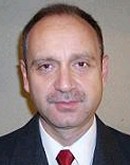Plenary Lecture
New Sensors for Diagnosis Based on Radio-medical Devices

Associate Professor Calin I. Ciufudean
“Stefan Cel Mare” Universtity of Suceava
Faculty of Electrical Engineering and Computer Science
Department of Automatics and Computers
ROMANIA
E-mail: calin@eed.usv.ro
Abstract: Radio frequency (RF) communication devices implanted in medical device can increase the range of applicability of the respective device and improve quality of life for the patient.
An actual challenge is designing an implantable antenna for operation in the MICS (Medical Implant Communication Service) band, 402 to 405 MHz, reserved for ultra low power communication with implanted medical devices. Developments in support electronics decrease design risk, but the implanted antenna remains a critical component of a communications link that operates at very low received power. Dielectric losses and wave trapping in the body result in transmission losses much greater than seen in free space communications.
For an implanted antenna, body tissues significantly perturb efficiency and operating bandwidth from their free space values.
Considering the above mentioned staff we are concerned about the data loss due to the RF communications implanted in medical devices, in order to perform a correct diagnose and/or treatment. Therefore, this paper is focused on the improvement of the automated medical diagnosis based on biological feature (BF) selection and classification, as we know that biological features represent patterns of important information. We see this new approach as complex radio implanted sensor which concur to a faster and better diagnosis. Medical diagnostic can be improved if the pattern is comprised by most of the significant biological features. In our study, common sequence measures were employed to determine the saliency of a wide range of applications in the area of medicine, computational biology, as well as string editing, pattern recognition and genetics etc. We assume that an important common sequence salience measure is to find the longest common subsequence (LCS) for a set of n sequences. In order to perform this hard task, we use discrete event formalisms, respectively Petri nets and we propose an algorithm for reducing the size of the digraphs. An interesting application to the ECG signals will demonstrate that salient input features effectively aid the diagnosis process.
Brief Biography of the Speaker:
• Academic Positions: Assoc. Professor Ph.D. Eng., Dept. of Automatics and Computers, Faculty of Electrical Engineering and Computer Science, “Stefan cel Mare” University of Suceava, Romania.
• Fields of Scientific Activities: Discrete Event Systems, Complex Measurement Systems, Reliability and Diagnosis of Control Systems, Environmental Management.
• He published 11 books, 12 patents and over 160 scientific papers in conference proceedings and journals.
• Honor Member of the Romanian Society of Electrical & Control Engineering - Member of the Romanian Technical Experts Corp.
• Technical Expert of the Romanian Ministry of Justice.
• President of the Romanian Society of Electrical & Control Engineering, Suceava Branch.
• He is a member of the editorial boards of several international scientific journals and conferences of control systems and electric engineering science. He was designated chairmen at 21 international conferences.